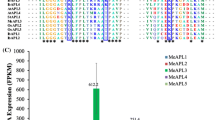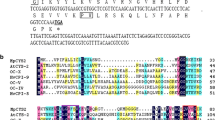Abstract
The storage roots of cassava (Manihot esculenta Crantz) suffer from a rapid post-harvest deterioration that is a major constraint to their increased exploitation. In many ways this deterioration resembles wound responses in other better studied plant systems, though it appears to lack an adequate wound repair response. A cDNA clone (cMeHRGP1) for a hydroxyproline-rich glycoprotein expressed during the deterioration response was isolated and characterised. This clone proved to be an antisense pairing, coding for part of phosphoserine aminotransferase on its complementary strand. Messenger RNA corresponding to cMeHRGP1 accumulated in deteriorating cassava roots from day three after harvest, by which time the deterioration response was well advanced. There by confirming that aspects of the wound repair response were inadequate in harvested cassava roots.
Similar content being viewed by others
References
Altschul, S.F., T.L. Madden, A.A. Schaffer, J. Zhang, Z. Zhang, W. Miller & D.J. Lipman, 1997. Gapped BLAST and PSI-BLAST: a new generation of protein database search programs. Nucleic Acids Res 25: 3389–3402.
Anonymous, 1994. Cassava biotechnology research priorities 1995. Cassava Biotechn Newsl 2: 15–16.
Beeching, J.R., A.D. Dodge, K.G. Moore, H.M. Phillips & J.E. Wenham, 1994. Physiological deterioration in cassava: possibilities for control. Trop Sci 34: 335–343.
Beeching, J.R., A.D. Dodge, K.G. Moore & J.E. Wenham 1995. Physiological Deterioration in Cassava: An Incomplete Wound Response? In: A.-M. Thro & W. Roca (Eds.), The Cassava Biotechnology Network: Proc Second Int Sci Meet, pp. 729–736. CIAT, Cali, Colombia.
Beeching, J.R., Y. Han & R.M. Cooper, 1997. Physiological deterioration in cassava: towards a molecular understanding. Afric J Root Tuber Crops 2: 99–105.
Beeching, J.R., Y. Han, R. Gómez-Vásquez, R.C. Day & R.M. Cooper, 1998. Wound and defense responses in cassava as related to post-harvest physiological deterioration. Recent Adv Phytochem 32: 231–248.
Beeching, J.R., H. Li, Y. Han, H. Buschmann, R. Cooper, R. Gómez-Vásquez, K. Reilly, M.X. Rodriguez & J. Tohme, 2000. Phenylalanine Ammonia-Lyase Gene Structure and Activity in Cassava. In: L.J.C.B. Carvalho, A.M. Thro & A.D. Vilarinhos (Eds.), Cassava Biotechnology. IVth Intl Sci Meet Cassava Biotech Netw, pp. 551–559. Brasilia: Embrapa.
Bennett, R.N. & R.M. Wallsgrove, 1994. Secondary metabolites in plant defense-mechanisms. New Phytol 127: 617–633.
Bonnelye, E. & V. Laudet, 1994. Overlapping genes. Med Sci 10: 805–816.
Booth, R.H., 1976. Storage of fresh cassava (Manihot esculenta). I. Post-harvest deterioration and its control. Exp Agric 12: 103–111.
Bowles, D.J., 1990. Defense-related proteins in higher plants. Annu Rev Biochem 59: 873–907.
Bown, D.P., G.P. Bolwell & J.A. Gatehouse, 1993. Characterization of potato (Solanum tuberosum L.) extensins - a novel extensinlike cDNA from dormant tubers. Gene 134: 229–233.
Bradley, D.J., P. Kjellbom & C.J. Lamb, 1992. Elicitor-induced and wound-induced oxidative cross-linking of a proline-rich plantcell wall protein - a novel, rapid defense response. Cell 70: 21–30.
Brownleader, M.D., P.E. McNally, G.E.A. Davies, M. Trevan & P.M. Dey, 1997. Elicitor-induced extensin insolubilization in suspension-cultured tomato cells. Phytochem 46: 1–9.
Buschmann, H., M.X. Rodriguez, J. Tohme & J.R. Beeching, 2000. Qualitative and quantitative changes of phenolic components of cassava (Manihot esculenta Crantz). In: L.J.C.B. Carvalho, A.M. Thro & A.D. Vilarinhos (Eds.), Cassava Biotechnology. IVth Intl Sci Meet Cassava Biotechn Netw, pp. 517–525. Brasilia: Embrapa.
Cebrat, S., P. Mackiewicz & M.R. Dudek, 1998. The role of the genetic code in generating new coding sequences inside existing genes. Biosystems 45: 165–176.
Chang, S., J. Puryear & J. Cairney, 1993. A simple and efficient method for isolating RNA from pine trees. Plant Molec Biol Rep 11: 113–116.
Chen, J. & J.E. Varner, 1985. An extracellular matrix protein in plants: Characterisation of a genomic clone for carrot extensin. EMBO J 4: 2145–2151.
CIAT, 1992. Cassava Programme 1987–1991. Working Document 116. CIAT, Cali, Colombia.
Cock, J.H., 1985. Cassava: New Potential for a Neglected Crop. Westfield Press, Boulder.
Corbin, D.R., N. Sauer & C.J. Lamb, 1987. Differential regultion of a hydroxyproline-rich glycoprotein gene family in wounded and infected plants. Molec Cellular Biol 7: 4337–4344.
Czyhrinciw, N. & W. Jaffé, 1951. Modificaciones quimicas durante la conservacion de raices y tuberculos. Archiv Venez Nutric 2: 49–67.
Dellaporta, S.L., J. Wood & J.B. Hicks, 1983. A plant DNA minipreparation: Version II. Plant Molec Bio Rep 1: 19–21.
Dixon, R.A. & N.L. Paiva, 1995. Stress-induced phenylpropanoid metabolism. Plant Cell 7: 1085–1097.
Ecker, J.R. & R.W. Davis, 1987. Plant defence genes are regulated by ethylene. PNAS 84: 5202–5206.
Hahlbrock, K. & D. Scheel, 1989. Physiology and molecular biology of phenylpropanoid metabolism. Annu Rev Plant Physiol Plant Mol Biol 40: 347–369.
Han, H., H. Li, R.M. Cooper & J.R. Beeching, 2000. Isolation of post-harvest physiological deterioration related cDNA clones from cassava. In: L.J.C.B. Carvalho, A.M. Thro & A.D. Vilarinhos (Eds.), Cassava Biotechnology. IVth Intl Sci Meet Cassava Biotechn Netw, pp. 526–536. Brasilia: Embrapa.
Hirose, S., 1986. Physiological studies on postharvest deterioration of cassava plants. Jap Agric Res Quart 19: 241–252.
Hirose, S., E.S. Data & M.A. Quevedo, 1984. Changes in respiration and ethylene production in cassava roots in relation to postharvest deterioration. In: I. Uritani & E.D. Reyes (Eds.), Tropical Root Crops: Postharvest Physiology and Processing, pp. 83–98. Japan Scientific Societies Press, Tokyo.
Hirsinger, C., Y. Parmentier, A. Durr, J. Fleck & E. Jamet, 1997. Characterization of a tobacco extensin gene and regulation of its gene family in healthy plants and under various stress conditions. Plant Molec Biol 33: 279–289.
Janssen, W. & C. Wheatley, 1985. Urban cassava markets - the impact of fresh root storage. Food Policy 10: 265–277.
Joshi, C.P., H. Zhou, X. Huang & V.L. Chiang, 1997. Context sequences of translation initiation codon in plants. Plant Molec Biol 35: 993–1001.
Kawalleck, P., E. Schmelzer, K. Hahlbrock & I.E. Somssich, 1995. Two pathogen-responsive genes in parsley encode a tyrosinerich hydroxyproline-rich glycoprotein (HRGP) and an anionic peroxidase. Molec Gen Genet 247: 444–452.
Kieliszewski, M.J. & D.T.A. Lamport, 1994. Extensin: repetitive motifs, functional sites, post-translational codes, and phylogeny. Plant J 5: 157–172.
Kimelman, D. & M.W. Kirschner, 1989. An antisense messenger RNA directs the covalent modification of the transcript encoding fibroblast growth-factor in Xenopus oocytes. Cell 59: 687–696.
Knee, R. & P.R. Murphy, 1997. Regulation of gene expression by natural antisense RNA transcripts. Neurochem Internat 31: 379–392.
Lalaguna, F. & M. Agudo, 1989. Relationship between changes in lipid with ageing of cassava roots and senescence parameters. Phytochem 28: 2059–2062.
LeJohn, H.B., L.E. Cameron, B. Yang & S.L. Rennie, 1994. Molecular characterization of an NAD-specific glutamatedehydrogenase gene inducible by L-glutamate - antisense gene pair arrangement with L-glutamate-inducible heat-shock 70-like protein gene. J Biol Chem 269: 4523–4531.
Li, H., Y. Han & J.R. Beeching, 2000. Isolation and characterisation of an ACC oxidase gene from cassava. In: L.J.C.B. Carvalho, A.M. Thro & A.D. Vilarinhos (Eds.), Cassava Biotechnology. IVth Intl Sci Meet Cassava Biotechn Netw, pp. 582–589. Brasilia: Embrapa.
Lindsey, J.S., 1991. Self-assembly in synthetic routes to molecular devices - biological principles and chemical perspectives - a review. New J Chem 15: 153–180.
Mann, C., 1997. Reseeding the green revolution. Science 277: 1038–1043.
Murashige, T. & F. Skoog, 1962. A revised medium for rapid growth and bioassays with tobacco tissue cultures. Physiol Plant 15: 473–497.
Olsen, K.M. & B.A. Schaal, 1999. Evidence on the origin of cassava: phylogeography of Manihot esculenta. Procl Nat Acad Sci USA 96: 5586–5591.
Piperno, D.P. & I. Holst, 1998. The presence of starch grains on prehistoric stone tools from the humid neotropics: Indications of early tuber use and agriculture in Panama. J Archaeol Sci 25: 765–776.
Plumbley, R.A., P.A. Hughes & J. Marriot, 1981. Studies on peroxidases and vascular discoloration in cassava root tissues. J Sci Food Agric 32: 723–731.
Reilly, K., Y. Han, J. Tohme & J.R. Beeching, 2000. Oxidative stress related genes in cassava post-harvest physiological deterioration. In: L.J.C.B. Carvalho, A.M. Thro & A.D. Vilarinhos (Eds.), Cassava Biotechnology. IVth Intl Sci Meet Cassava Biotechn Netw, pp. 560–571. Brasilia: Embrapa.
Rickard, J.E. & D.G. Coursey, 1981. Cassava storage. Part 1: Storage of fresh cassava roots. Trop Sci 23: 1–32.
Rickard, J.E. & P.B. Gahan, 1983. The development of occlusions in cassava (Manihot esculenta Crantz) root xylem vessels. Ann Bot 52: 811–821.
Rodriguez, M.X., H. Buschmann, J. Tohme & J.R. Beeching, 2000. Production of anti-microbial compounds in cassava (Manihot esculenta Crantz) root during post-harvest physiological deterioration. In: L.J.C.B. Carvalho, A.M. Thro & A.D. Vilarinhos (Eds.), Cassava Biotechnology. IVth Intl Sci Meet Cassava Biotechn Netw, pp. 320–328. Brasilia: Embrapa.
Sakai, T. & Y. Nakagawa, 1988. Diterpenic stress metabolites from cassava roots. Phytochem 27: 3769–3779.
Sambrook, J., E.F. Fritsch & T. Maniatis, 1989. Molecular Cloning: A Laboratory Manual. Cold Spring Harbor Press, Cold Spring Harbor.
Schumacher, H.M., H. Gundlach, F. Fiedlar & M.H. Genk, 1987. Elicitation of benzophenanthridine alkaloid synthesis in Escholtzia cell cultures. Plant Cell Rep 6: 410–413.
Showalter, A.M., A.D. Butt & S. Kim, 1992. Molecular details of tomato extensin and glycine-rich protein gene-expression. Plant Molec Biol 19: 205–215.
Silke, J., 1997. The majority of long non-stop reading frames on the antisense strand can be explained by biased codon usage. Gene 194: 143–155.
Sommer-Knudsen, J., A. Bacic & A.E. Clarke, 1998. Hydroxyproline-rich plant glycoproteins. Phytochem 47: 483–497.
Tanaka, Y., E.S. Data, S. Hirose, T. Taniguchi & I. Uritani, 1983. Biochemical changes in secondary metabolites in wounded and deteriorated cassava roots. Agric Biol Chem 47: 693–700.
Tierney, M.L., J. Wiechert & D. Pluymers, 1988. Analysis of the expression of extensin and p33-related cell-wall proteins in carrot and soybean. Molec Gen Genet 211: 393–399.
Uritani, I., E.S. Data & Y. Tanaka, 1984. Biochemistry of postharvest deterioration of cassava and sweet potato roots. In: I. Uritani & E.D. Reyes (Eds.), Tropical Root Crops: Postharvest Physiology and Processing, pp. 61–75. JSSP: Tokyo.
Wenham, J.E., 1995. Post-harvest Deterioration of Cassava. A Biotechnological Perspective. FAO, Rome.
Wheatley, C. & G. Gomez, 1985. Evaluation of some quality characteristics in cassava storage roots. Qual Plant Foods Hum Nutr 35: 121–129.
Wheatley, C.C. & W.W. Schwabe, 1985. Scopoletin involvement in post-harvest physiological deterioration of cassava root (Manihot esculenta Crantz). J Exp Bot 36: 783–791.
Author information
Authors and Affiliations
Rights and permissions
About this article
Cite this article
Han, Y., Gómez-Vásquez, R., Reilly, K. et al. Hydroxyproline-rich glycoproteins expressed during stress responses in cassava. Euphytica 120, 59–70 (2001). https://doi.org/10.1023/A:1017547419332
Issue Date:
DOI: https://doi.org/10.1023/A:1017547419332




